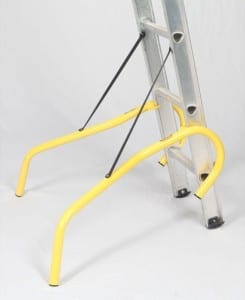It was like we were back in school. Recently roofingcontractor.com gave us a pop quiz on ladder safety. We broke out in a sweat. But there was no getting around the imminent revealing of ignorance. We’ve used ladders and lived to tell the tale, so we know what we’re doing, right? Maybe your run of ladder safety was just luck. According to OSHA, there are hundreds of deaths and tens of thousands of injuries each year from ladder use. You may literally be taking your life in your hands when getting on and off the thing. Many companies also need a fall protection plan to be fully compliant with OSHA. We’ve written about power tool accidents to avoid, wiring safety tips, jobsite safety tips, and now here are 10 ways to avoid ladder injuries.
Follow These Tips to the Ladder
1) Inspect. Be sure there’s no damage, that locking mechanisms are functional, welds or bolts holding stiles and rungs together are solid, and there’s no mud or dirt inhibiting non-slip features of the rungs.
2) Beware the extension ladder’s change from 2 rungs deep to 1. Descending a ladder is fraught with danger anyway, but when the 2 rung area of the extension ladder’s overlap drops to just a single rung width, it can cause instability and a fall. Descend slowly.
3) The ladder should extend 3 feet above a roof. This length allows safe engagement and disengagement for project that require getting on the roof. If your ladder barely reaches to the edge of a roof—it’s not tall enough.
4) The ladder must have at least a 4:1 slope. A steep ladder is a dangerous ladder that can easily fall backward. For every 4 feet of height, the ladder should be 1 foot from base of the structure. Some modern ladders are even starting to include a built-in level to assure you get the angle correct.
5) Consider a ladder stabilizer. Some are designed for use at the bottom while others attach near the top, but both provide extra stability.

Halfway through the 10 ways to avoid ladder injuries
6) Don’t stand above the 4th rung from the top. Don’t be a hero.
7) Load capacity includes everything on the ladder. Body weight, clothing, tools, all contribute to the ladder’s load. Make sure you’re choose the right ladder type when you’re climbing.
8) Always have at least three points of contact with the ladder. With two feet and one hand or two hands and one foot, you’re less likely to be off balance with the three points rule. An elbow is not a point of contact.
9) Consider building temporary rails around the top of a ladder. Make roof jobs with a lot of entry and exit from the ladder safer with temporary rails on the roof. You also want to minimize the amount of climbing by organizing trips to reduce the amount of travel to and from the roof.
10) Your shoulders shouldn’t move outside the ladder’s stiles. Keep your balance by not overreaching.
We hope you’ve found useful information in these 10 Ways to Avoid Ladder Injuries. If you’re a Pro and you have a ladder safety tips, add them in the comments below—or contact us with your own Pro tips. Climb safely!



